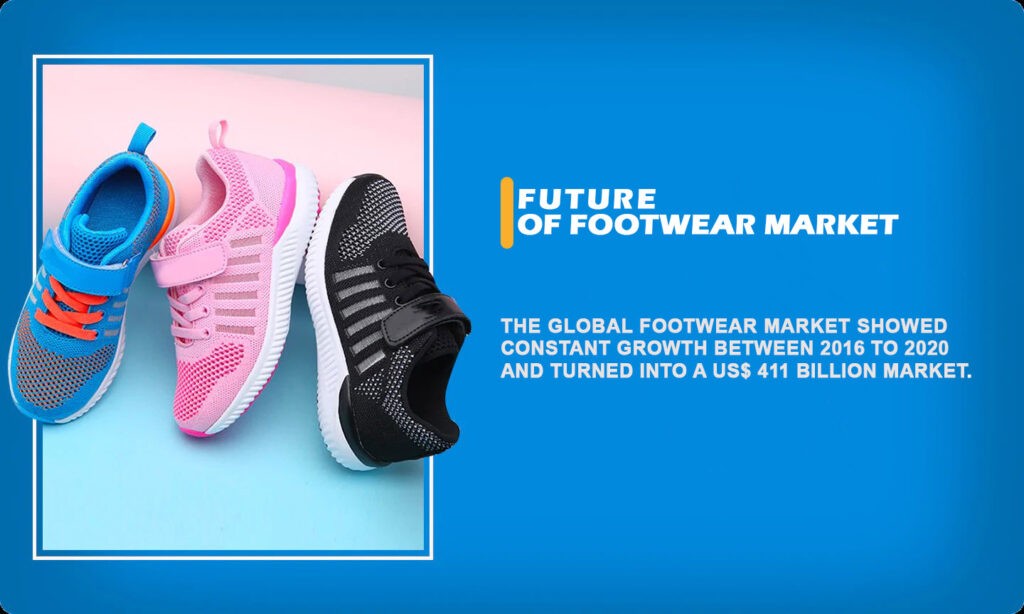The footwear market has faced a massive crisis during this pandemic. No sector has been left untouched by this pandemic. The only difference is that some sectors have made huge profits while some faced a crisis. The footwear industry is one of them, especially the wholesale footwear market. But thanks to this digital era, some of them survived. This pandemic has pushed companies, industries to restructure their working norms and strategize according to the current scenario. However, the world is slowly getting back to normal, but still, there is tough competition for wholesale suppliers.
India stands at the second position in the producer and consumer category for footwear at global standard, with China being at the top. The countries have adopted various marketing techniques like b2b models to stand out at the international front.
Future of footwear market

According to a report, the global footwear market showed constant growth between 2016 to 2020 and turned into a US$ 411 billion market. This increased from the wholesale footwear suppliers. Seeing the profit of this industry, many entrepreneurs entered this market. The credit goes to the wide range of varieties available and b2b options that acted as an invitation for all. In the varieties sections, From flats to wedges, boots to stilettos, brogues to sneakers, etc., this market has never failed to attract consumers, especially women. On the other hand, b2b models have brought the marketplace on the screens. Among all, there is a b2b platform global trade plaza. Here, there are multiple options and platforms for the advertisement. Whether, big or small, anyone can increase business reach with them.
Undeniably, the pandemic brought a halt to the footwear market’s pace, and the imposed lockdown worsened the situation. As India holds the second-largest producer of footwear position in the world thus acts as the source of employment for many. It ranks fourth in the production of leather globally. But the lockdown resulted in the non – production, hence unemployment, no exports, and no revenue generated. The decline in footwear consumption has adversely affected the wholesale shoe market as the wholesalers are left with the bulk of unsold footwear. However, it is expected that a change in the working culture and remodeling of the designs can help the shoe market to get back to its original track.
A rise in medically designed footwear

From the past few years, there has been an increase in the demand for therapeutic footwear. The group of consumers seeking such footwear is old age people and people with chronic disease. This type of footwear not only relieves pain but also reduces abrasions. There is also specialized footwear available for people with diabetes, obesity, allergies, etc. There is a speculation that the upcoming period in these medically designed footwear will increase. The top layers in the footwear industry have started coming up with medically designed footwear for sports and daily use. The market of this kind of footwear is relatively higher than any upcoming trends.
Important factors to be considered in the footwear industry

Before manufacturing any product, certain factors need to be considered, like the quality and cost of the raw material, the design, the steps involved in manufacturing, and its impact on the environment. A lot of industries have come up with eco-friendly and consumer-friendly innovations. Their rising demand and profits are attracting more wholesale suppliers to enter the market. But many challenges are affecting the manufacturers. Swift changes in design and material, new suppliers’ entrance, increased competition, financial constraints, and rising labor costs are some of the manufacturers’ perils.
India in the footwear market
India is a hub of many wholesale footwear markets. The wholesale shoe suppliers try to pick up the best products according to the consumer demand and either export them or sell them internally. Since India is the second-largest producer of footwear, it contributes nearly 13% in global production of 16 billion pairs of footwear with the most number of leather shoes and thus a sector with employment to millions. The annual export of footwear from India is nearly 115 million pairs.
Agra, Delhi, Kolkatta, Ludhiana, Calicut are some of India’s major footwear production centers. The prime importers of Indian footwear are the US and European countries, accounting for nearly 90% of India’s footwear exports. This increases the chances for wholesale footwear suppliers to export in bulk. Some of the best wholesale shoe Indian markets are listed below:-
Wholesale market in Delhi
The footwear market in Mumbai
Agra Market of wholesale shoes
These markets require time investment from the consumers as there is a wide variety of footwear available at economical prices.
Popular footwear price domain
There is a large variety of footwear available in the market, and therefore with each type comes a different price domain. Also, there is a huge variance in the local produce and the imported. Each price domain has its kind of consumer market. Since nearly 50% of the world’s population belongs to economic class, the demand for economic class footwear is comparatively more than others.
The products from the manufacturing units land into general merchandise stores, e-commerce websites, malls, etc. The available merchandise stores hold a large scale market share as these stores prowess on a single product only and are quite popular among consumers.
The Market Players
The leading players in the footwear market are the famous brands like BATA, Reebok, Puma, Adidas AG, Nike Inc., Polartec, Geox, Skechers USA, Timberland, The Aldo Group, New Balance, Columbia Sportswear and Asics Corp, Jack Wolfskin. These players carefully and thoroughly evaluate the market, latest trends, historical and statistical data, and then estimate the success rate.
Competitive Scenario
Being a multi-billion US dollar industry, the footwear market is justly fragmented all over the world. It is highly competitive because of the existence of both local and foreign players. In India, the government has allowed 100% foreign direct investment in the footwear industry. The greater the investment, the greater the chances of foreign companies entering the market and greater competition for the locals to survive.
Due to the rising competition, the manufacturers’ collaboration with other market players geographically extend their reach and strengthen their portfolios. The cut-throat competitive nature of this industry has led to environmentally friendly innovations and consumer-friendly innovations. For example, India’s Khadi and Village Commissions has introduced a footwear range made up of khadi fabric. This is the first-ever top-quality khadi footwear range.
It is forecasted that by December 2021, the footwear market will catch its pace back again. Since India is the second-largest consumer and producer globally, its growth is estimated to be $ 15.5 billion by 2024. Such a rise will impact the wholesale footwear suppliers as more opportunities will open for them.

